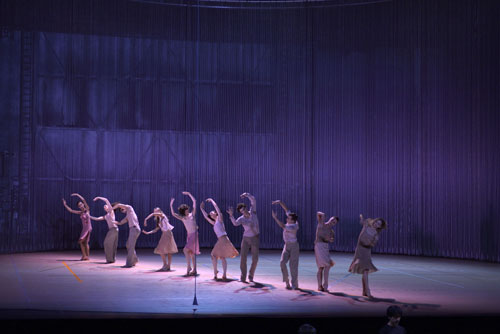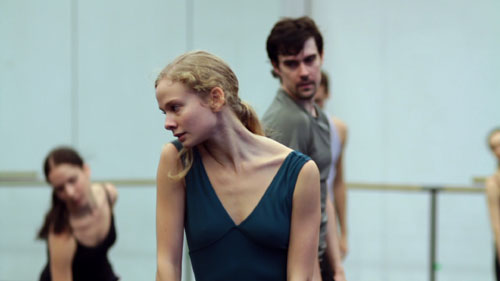|
“Ballet is a fight against gravity. In “Rain” you must give it free reign.”
These words, spoken by one of the ballerinas of the Ballet de l’Opéra national de Paris, summarize the unlearning that was necessary to master the movement vocabulary of Anne Teresa de Keersmaeker’s “Rain”. “Rain” is a complex and difficult piece of choreography that would be an enormous challenge for any dancer. The classically trained ballet dancers of the Opéra de Paris rose to the challenge and danced the seventy-minute work with precision, fire and feeling. And also undoubtedly suffered bruises, injured muscles and scraped feet and ankles as they learned to give in to gravity and take to the floor.
De Keersmaeker’s obsession with perfection inspired her to create this work of dazzling technical difficulty. Artists working throughout the ages in all media have been fascinated by the mathematical concepts that describe perfection. This work is particularly satisfying because the mathematical precision gives way to an emotional experience that is at once visual and visceral.
In creating “Rain,” De Keersmaeker employed complex criss-crossing of geometrical motifs painted on the stage as well as drawings of spirals swirling around the stage. The dancers moved around and across the stage according to these patterns and their movement embodied angles, spirals and circles. A technical tour de force, “Rain” succeeds on an emotional level as each dancer expresses her or his own personal interpretations and their relationships as partners or dancers in a group.
The work opens with the ten dancers carving large circles and spirals in space defined by a semi-circular curtain of shimmering rope. A human-sized bright light races around the outside of the curtain, (thankfully) just once at the beginning and once at the end. Eventually the movement evolves from highly athletic running in specific horizontal patterns to expressing these patterns vertically in the dancers’ bodies and in the shapes they form in duos and trios.
 |
Driven by the relentlessly repetitive music of Steve Reich, “Music for Eighteen Musicians,” De Keersmaeker layers movement that is angular and circular, grounded and airborne, sensual and intellectual, personal and yet rigorously codified for the group. If there is a piece of choreography that is more technically and athletically demanding than “Rain,” I have never seen it. As the dancers pushed themselves through increasingly difficult patterns, often involving complex lifts and complicated floor-work, their ribcages heaved as they pulled in enough oxygen to continue.
At intervals, the whole group broke apart into carefully planned and tightly executed smaller groups in which each performed a variation until De Keersmaeker finally sent them into a long line where they would perform a canon of movement that cascaded down the line beginning downstage. The visual relief from the near chaos paired with compassion for the dancers who finally got to catch their breath! The inclusion of these intermittent line dances was reminiscent of Pina Bausch in the way she would use the repetition of simple movement motifs to powerful emotional effect. I wonder if I was alone among the audience members in wishing to join the dancers in performing these beautifully lyrical phrases in which each dancer was given license to move and breathe to their own rhythm.
 |
One dancer, Léonore Baulec, seemed to have been born to dance “Rain.” While the others visibly labored at times, she rose far above the rigors of the technique to bring a joyous, spritely quality to each phrase. Miraculously, she seemed to gain energy and her movement gained clarity as the piece drove toward its conclusion. Her role fittingly also grew as she performed several astonishing duets and mini solos toward the end. Her speed and precise balance, whether centered or off-center, enabled her to inflect her phrasing with unique rhythm and to be a leader as well as a sparkling presence within the group.
Filmmakers Olivia Rochette and Gerard-Jan Claes created an award-winning documentary about the process of de Keersmaeker’s dance company members, Rosas, teaching “Rain” to the French ballet dancers. Also entitled, “Rain” it is a somewhat nonlinear collage of scenes that reveals the complex world behind the curtain.
The opening dance scenes show the Rosas dancers teaching the movement as De Keersmaeker watches. She comes across as both detached and anxious as the dancers grapple with her style and the lengthy complex form of her choreography. It turns out that this rehearsal is an audition to see which of the 154 dancers of the Ballet de l’Opéra de Paris will perform the piece in repertory. When asked if she liked any of the dancers, she responded, “I like the blonde. The one with the curls.” Léonore Baulec, as I wrote above, was a natural while most of the other dancers struggled.
The company is notorious for its ruthless politics and union protections. Even the idea that an individual dancer would be singled out in the documentary became a near controversy and the filmmakers were told, in a recorded phone conversation, that the camera could not be perceived as following a single dancer lest this cause the others to feel neglected. In another scene it was revealed that one of the soloists had stormed out of rehearsal because she felt she was not receiving enough attention. Other scenes portrayed the juxtaposition of the elaborate set and staging of “Romeo and Juliet” contrasted against the stark staging and costuming of “Rain.” As the dancers prepared their hair, costumes and, most importantly, their feet and pointe shoes, enormous set pieces even including a great white horse were paraded around backstage.
Footage of the rehearsals for “Rain” appear most grueling when the dancers practice the unfamiliar movements requiring them to fall repeatedly to the floor and rise back up again. They eventually master the material and appear to flop down as if boneless. Close-up shots of their bloody feet and ankles reveal otherwise. Ah, the pain of perfection.
Photography: Benoite Fanton/Opéra national de Paris and
Savage Films, Olivia Rochette & Gerard-Jan Claes
|